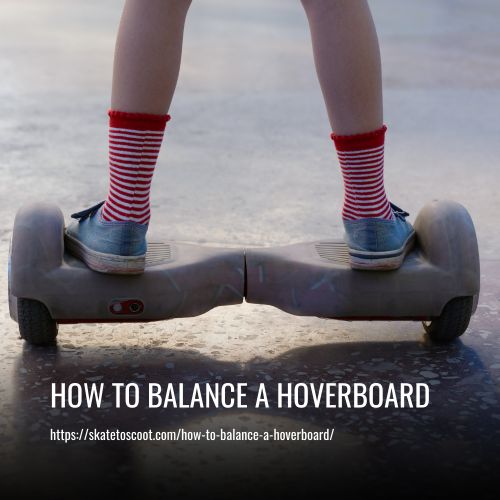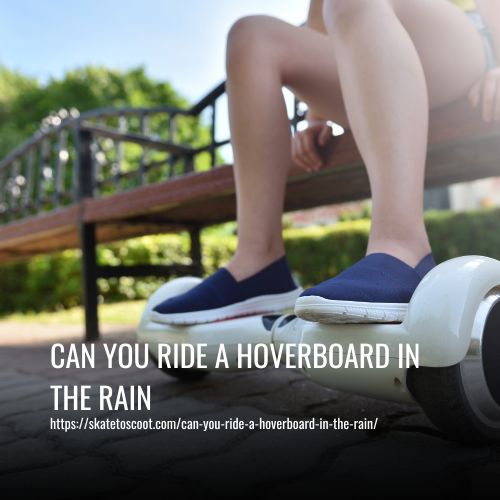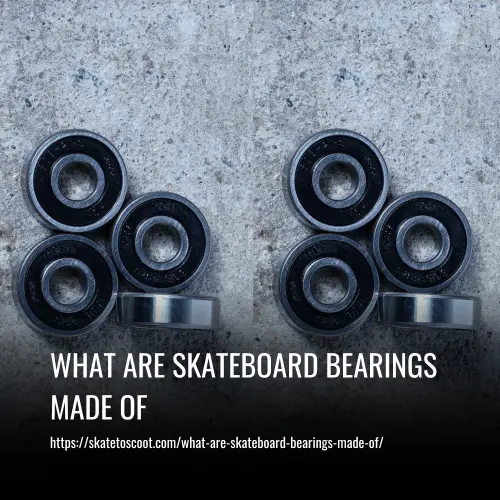As an Amazon Associate we earn from qualifying purchases.
Hoverboards are a fun and exciting way to get around, but they can be tricky to balance. If you’re new to hoverboarding or just can’t seem to stay upright, don’t worry – it’s a skill that can be learned with practice and some helpful tips.
To Balance A Hoverboard, follow these steps:
- Stand with the Left Foot on the Central Pivot Point.
- Slowly Lean Forward and Place Your Right Foot in Position.
- Start Moving the Feet in Small Steps to Balance Properly a Hoverboard.

Basics of Balancing on a Hoverboard:
Hoverboards, also known as self-balancing scooters, have become a popular mode of transport among kids and adults alike. However, getting the hang of balancing on one can be challenging for beginners. In this article, we’ll explore the basics of balancing on a hoverboard and help you master the art of gliding through the streets like a pro.
Step 1: Stand with the Left Foot on the Central Pivot Point
When stepping onto a hoverboard, it’s crucial to position your left foot correctly on the central pivot point. The pivot point is where the two electric motors of the hoverboard meet in the center, and by standing on this point, you’ll be able to maintain balance and prevent accidents.
To achieve this, first, turn on the hoverboard and check the battery gauge to ensure that it has enough power to operate. Position the hoverboard near something stable to hold onto while getting on the device. Then, place your left foot first onto the central pivot point and use the support to balance yourself. Slowly bring your right foot onto the board and center your body weight for optimal balance. With this in mind, you’ll be able to master the essential first step of stepping onto a hoverboard.
Step 2: Slowly Lean Forward and Place your Right Foot in Position
To balance on a hoverboard, it is critical to learn the right way to position your feet. The first step is to place your left foot correctly on the central pivot point of the device. Once that is done, the next step is to slowly lean forward while keeping a close eye on the horizon. While doing so, engage your core muscles, which will help you maintain balance and prevent sudden jerks.
Now, bring your right foot up slowly, positioning it parallel to your left foot. It is recommended that you take your time to ensure the right positioning of your right foot. Be sure not to put too much weight on it, as this can cause the hoverboard to become unbalanced. Practicing this movement slowly is advised until you can find your balance comfortably.
Step 3: Start Moving the Feet in Small Steps to Balance Properly a Hoverboard
Once you have positioned your feet on the hoverboard, it’s time to start moving your feet in small steps to achieve balance. Begin by keeping your feet flat on the hoverboard and centered over the central pivot point. Take slow and deliberate movements, making sure to transfer your weight evenly between your feet.
Take small steps forward with your right foot while keeping your left foot stationary. Gradually transfer your weight onto your right foot by slightly lifting your left foot off the hoverboard. Then, take small steps backward with your right foot while keeping your left foot in place and centered over the central pivot point.
Why Should I Balance a Hoverboard?
Balancing a hoverboard is crucial for several reasons. One of the foremost reasons is the safety of the rider. As hoverboards utilize a complicated system of electric motors, sensors, and a built-in gyroscope to maintain balance, it’s essential to keep them balanced for optimal performance and to prevent accidents. If the hoverboard is not balanced, the rider can fall and cause injuries.
Moreover, balancing a hoverboard helps to maintain stability and keeps the rider in control while riding. It’s also a good workout for your core muscles, including the lower back and abdominal muscles. Finally, keeping the hoverboard balanced ensures the longevity and efficiency of the battery life, as well as the wheels & headlight system, resulting in a smoother and safer ride. Therefore, it’s imperative to balance the hoverboard to ensure stability, control, safety, workout, and battery life.
A Balancing Act for a Hoverboard:
Hoverboards, also called self-balancing scooters or smart boards, rely on balance to give riders a seamless experience. Hoverboards may seem magical, but they’re more than just fun and games.
Hoverboards usually have a frame with a central pivot, a logic board, a pair of gyroscopes and infrared sensors, two electric motors with speed/tilt sensors, a power switch, a charging port, a lithium-ion battery pack, LED indicator lights and pressure plates under the footpads. It is the workings of all these components that make hoverboards seem like they’re defying gravity.
Hoverboard Logic Boards
Hoverboards or self-balancing scooters consist of several essential components, one of which is the logic board. The logic board is the primary processor that receives information from the sensors and processes the data in real-time. It is responsible for computing the speed, incline, relative tilt angle, and speed of each wheel relative to each other.
The logic board’s role is crucial in ensuring the optimal performance of your hoverboard. Proper maintenance of the logic board can affect the control of your hoverboard and ultimately affect your riding experience. If the board is faulty, it may result in an accident and damage the device. Thus, always ensure that the logic board is in good condition and properly calibrated for an enjoyable hoverboard experience.
Detecting Movement
Hoverboards detect movement by monitoring pressure-sensitive footpads with infrared (IR) sensors. Each footpad has two switches, an IR light, and an IR sensor. When the sensor detects the IR light, the hoverboard’s logic board tells the motor to remain stationary.
However, when the rider leans forward, the front switch of the footpad is activated, blocking the IR light and disrupting the sensor. This movement prompts the logic board to power up the motor. If the left switch is activated, the hoverboard will turn right, and if the right switch is activated, the hoverboard will turn left. Finally, if both switches are activated simultaneously, the hoverboard moves forward.
Detecting the Tilt and Speed of a Hoverboard:
Hoverboards are powered by electric motors inside each wheel, otherwise known as hub motors. These motors rely on input from tilt and speed sensors, located at each wheel, to operate. The tilt sensors help to detect which direction the rider is leaning and in turn, control the forward or backward motion of the hoverboard.
To adjust the speed of the hoverboard, the rider needs to lean forward or backward. The more the rider leans, the faster the hoverboard will move, within reasonable limits. This is where speed sensors come into play, measuring how fast the wheels are spinning in RPM. They then send this information to the gyroscope and speed control boards, which monitor and adjust the speed of the hoverboard, ensuring optimal performance.
Hoverboard Gyroscopes and Speed Control:
Inside a hoverboard’s main housing, the speed control boards and the gyroscope receive RPM and tilt data from sensors in the wheels. After receiving this data, the information is sent to the logic board, which serves as the hoverboard’s brain and processes this information.
The gyroscope on a hoverboard helps to detect the board’s angle and its relation to the ground. During the calibration process, the gyroscope is “zeroed out,” effectively teaching it that a flat surface equals zero inclines. This calibration helps a hoverboard maintain balance when ridden.
Speed control is an important factor in hoverboard performance. Most hoverboards are designed to control their speed based on rider input. Riders can control their speed using a power switch or power button integrated into the hoverboard. Additionally, smooth and stable speed control can be maintained by keeping the hoverboard on a level or flat surface, and following the calibration process as instructed.
Simplicity is the Key
Hoverboard balancing is often perceived as a complex process, but it can be simplified into four key components. These components include sensors, motors, logic boards, and gyroscopes, which all work together to allow the hoverboard to balance itself when off-balance.
Despite being primarily used as a mode of transport and leisure, hoverboards require a high level of precision in terms of balance and calibration to achieve optimal performance. However, by understanding the basic components of the hoverboard’s self-balancing mechanism, users can rest assured that the calibration process is a simple one.
Simplicity is the key to ensuring that the hoverboard is well-balanced and performs optimally. By following a few simple steps, including placing the hoverboard on a flat surface and ensuring that it is calibrated correctly, users can enjoy a smooth and stable ride without any risk of losing balance or control.
Hoverboard Balance as Exercise?
Hoverboarding can provide a workout for core muscles, specifically the lower back and abs, leading to improved balance and muscle control with continued use. It is important to note that even self-balancing hoverboards require practice and muscle control for optimal performance.
By incorporating hoverboard riding as part of your workout routine, you can improve your balance, coordination, and flexibility while enjoying a fun and unique exercise. Simply start by carving out some space in a level and open area, wearing proper protection like elbow pads and wrist guards, and taking time to practice and perfect your balance strategies. Not only will it improve your overall physical health, but it will also add excitement and variety to your fitness routine.
The Future of the Balance
The future of the self-balancing technology industry is looking bright as designers and engineers seek to make hoverboards more advanced and refined. Recent improvements in the technology have led to a significant increase in hoverboard performance. The next-generation models will likely feature more advanced electric motors, tilt sensors, and logic boards.
In the near future, we can expect hoverboards to become more user-friendly, with a simpler calibration process that will enable riders to achieve optimal performance. Designs will focus on safety with built-in features such as elbow and wrist guards aimed at reducing the chances of injury during a ride. With the introduction of LED lights, wheels, and even charging ports, a hoverboard will be a versatile mode of transport for people of all ages.
It is also important that hoverboards are designed with a central pivot, which will enable better control and stability, even on uneven surfaces. Additionally, the use of advanced tilt angles and ankle joint balancing strategies will provide riders with a smoother and more comfortable ride.
FAQs
Begin by stepping onto the hoverboard one foot at a time, ensuring each foot is placed evenly. Keep your body upright and centered, distributing your weight equally between both feet.
If you feel unsteady, focus on maintaining a relaxed posture and use subtle movements in your ankles to adjust your balance. Keep your knees slightly bent to absorb any changes in terrain.
Practice regularly and start by mastering basic movements such as forward, backward, and turning. Engage your core muscles for stability and gradually increase your speed as you become more confident.
While age limits can vary by manufacturer, most hoverboards are designed for users above a certain weight and age limit. Always refer to the manufacturer’s guidelines and ensure you’re within the specified weight range for safe operation.
Check if the hoverboard is properly calibrated. If it continues to tilt, recalibrate the device following the manufacturer’s instructions. Ensure the surface you’re riding on is even to avoid unnecessary tilting.
Maintaining the correct body posture is crucial. Keep your back straight, look forward, and avoid leaning too far in any direction. Distribute your weight evenly over the hoverboard to maintain stability.
Conclusion:
Learning how to balance a hoverboard is crucial for a safe and enjoyable ride. By understanding your hoverboard’s features such as tilt sensors, logic board, and power switch, you will be able to calibrate it for optimal performance on a level and flat surface. Ensure that you are wearing appropriate safety gear, including elbow and wrist guards to reduce the risk of injury.
When riding a hoverboard, remember to keep your weight balanced between your left and right foot and use your ankle joint to maintain stability. Additionally, practice controlling your hoverboard’s speed and direction by adjusting your body’s tilt angles. By following these tips, you’ll be able to smoothly ride your hoverboard like a pro!
Amazon and the Amazon logo are trademarks of Amazon.com, Inc, or its affiliates.



